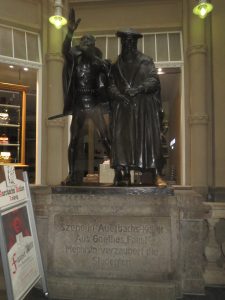In The Magic Battery, I play off the legend of Faust. There are many well-known versions of the story, including Marlowe’s play, Goethe’s play, and Gounod’s opera. Liszt was fascinated with the story and wrote a Faust Symphony as well as the Mephisto Waltzes. My treatment is a free one, but it starts from what’s known of the historical Faust. Or should I should say historical Fausts?
Johann Faust was born in 1466, or maybe 1480. His name is sometimes given as Georg or Johann Georg. Several towns claim to be his birthplace. Could there have been two Fausts, both with a reputation for magic and born over a decade apart? This might explain the part of the story where he becomes young again.In 1587, someone published a Faustbuch, a collection of fantastic stories. It introduces the name of Mephistopheles, the devil who makes a pact with him. It was published during the height of the German witch frenzy and built on the belief that witches made pacts with the Devil.
It was Christopher Marlowe, though, who made the legend a permanent feature of literature. His Doctor Faustus dates from about 1590. It establishes the basic features of the story: Dr. Faust, seeking knowledge of magic and the dark arts, summons a devil called Mephistophilis. They make a pact in which Mephistophilis will serve him for a period of years and then claim his soul. That’s what happens in the end.
Rembrandt created an etching in 1652, usually called Faust in His Study.. I used it for the cover of The Magic Battery. There’s no evidence, though, that Rembrandt intended it as a picture of Faust.
The best-known version of the story today is Goethe’s. He published Faust: Part 1 in 1808 and Part 2 in 1832. It reverses the earlier stories; Goethe’s Faust is ultimately saved by his striving. This is the version that introduces Gretchen, his love interest. Part 1 is more popular; Part 2 is full of obscure allusions.
The questing Faust was prime material for the Romantic era. Spohr composed an opera called Faust in 1813, following sources less well known that Marlowe and Goethe. Berlioz’ cantata, La Damnation de Faust (1846), follows Goethe’s Part 1, but (spoiler alert in the title!) Faust ends up in Hell. Gounod’s opera Faust (1859) generally follows the plot of Part 1, but it turns Faust into a hedonist and sentimentalizes the story. Boito’s 1868 opera Mefistofele gives the story a more serious treatment.
The Faust story inspired symphonic music as well. As I already mentioned, Liszt wrote several Pieces with explicit ties to the legend. His Faust Symphony (1854) has three movements, titled “Faust,” “Gretchen,” and “Mephistopheles” respectively. The “Mephistopheles” movement uses mocking versions of themes from the Faust movement, reflecting Goethe’s idea that Mephistopheles is “the spirit that always denies.” The symphony concludes with a setting for tenor and chorus of the final lines from Goethe’s Part 2 (“Alles vergängliche …”).
Mahler’s Symphony No. 8 sets the final scene of Part 2 for voices and chorus. It ends with an overwhelmingly powerful treatment of “Alles vergängliche.” The symphony is called the “Symphony of a Thousand” because of the huge orchestra and chorus it requires. I’ve seen it performed by two orchestras and two choral societies that joined forces for the concert. “Overwhelming” wasn’t a strong enough word for that experience.
In 1926, F. W. Murnau released the silent movie Faust, which combines different versions of the story. The 1955 Broadway musical Damn Yankees, which was later made into a movie, turns it into a baseball story. Many other movies play on aspects of the legend.
In 1943 Thomas Mann published Doctor Faustus, a looser, 20th-century version of the story. I’ve never read it, so I won’t say more about it here.
In 1997 Michael Swanwick published Jack Faust. This starts with a version of Faust who is fairly close to the historical one. It’s aliens rather than a devil that make a deal with him, teaching him advanced science and engineering. The story has many parallels to Goethe’s story as well as amusing links to history. At one point he nails the periodic table to a church door. I made a point of meeting Swanwick at Philcon last year and getting my copy autographed. When I told him what I was working on, he recommended Steven Ozment’s books on German history. They were extremely useful to me.
Just as I’m writing this, I found out that Steven Ozment died about a month after Philcon, not very far from where I live.
Even when you reach into far countries and centuries-old legends, sometimes it all ends up very close to home.

Hi Gary – I remember reading long ago that Rachmaninoff’s first piano sonata may also have been inspired by some version of Faust, and have long thought that I could “hear” a Faustian program in the music. A web search turned up this analysis, pretty much in line with my thinking. https://www.gregandersonpiano.com/rachmaninoff-sonata-no-1.
Hi, Steve! Now I’ll have to listen to that sonata. Since I subscribe to Primephonic, that won’t be a problem. They list 36 recordings of it.